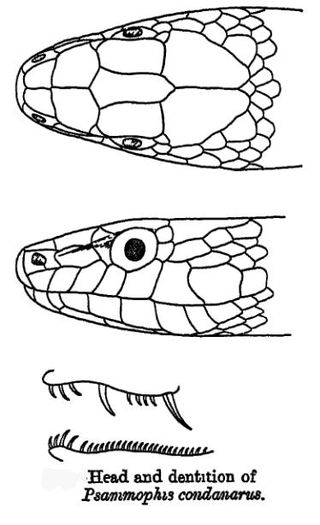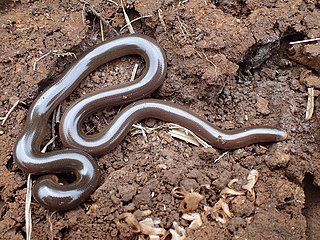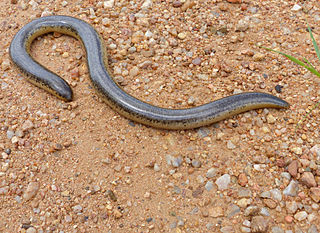
Psammophis condanarus, the sand snake, is a species of snake found in dry low country zones of Indian peninsula, Pakistan and Nepal. It is a fast-moving, diurnal, terrestrial species and lives in stony outcrops and boulders. It was first described from Ganjam area of Odisha State and then later on recorded from many parts of the Indian subcontinent.
Letheobia simonii is a blind snake species endemic to the Middle East. No subspecies are currently recognized.

Elapotinus is a monotypic genus created for the rear-fanged snake species, Elapotinus picteti. The species is endemic to Madagascar. It is also known commonly as Jan's snake in honor of Italian herpetologist Giorgio Jan. There are no subspecies that are recognized as being valid.
Hypoptophis is a monotypic genus created for the rear-fanged (opisthoglyphous) mildly venomous snake species, Hypoptophis wilsonii. The species, which is endemic to Africa, is in the subfamily Aparallactinae of the family Atractaspididae. There are no subspecies that are recognized as being valid.
The Cameroon racer, Poecilopholis cameronensis, is a species of rear-fanged mildly venomous snake endemic to Africa. Poecilopholis is a monotypic genus created for this species.
Aparallactus niger is a species of mildly venomous rear-fanged snake in the family Atractaspididae. It is endemic to Western Africa.

Atractaspis aterrima, commonly known as the slender burrowing asp or mole viper, is a species of fossorial, venomous snake in the family Atractaspididae. The specific epithet, aterrima, meaning "blackest", is the superlative form of the Latin adjective ater, meaning "black".
Polemon acanthias, or Reinhardt's snake-eater, is a species of mildly venomous rear-fanged snake in the family Atractaspididae. It is endemic to Africa.

Polemon collaris, or the collared snake-eater, is a species of mildly venomous rear-fanged snake in the family Atractaspididae. It is endemic to Africa.
Polemon gracilis, or the graceful snake-eater, is a species of mildly venomous rear-fanged snake in the family Atractaspididae. It is endemic to Africa.

Leptotyphlops nigricans, also known as the black threadsnake or black worm snake, is a species of snake in the family Leptotyphlopidae. It is endemic to Africa.

Aparallactus guentheri, or the black centipede-eater, is a species of mildly venomous rear-fanged snake in the family Atractaspididae. The species is endemic to Africa.

Aparallactus lunulatus, or the reticulated centipede-eater, is a species of mildly venomous rear-fanged snake in the family Atractaspididae, which is endemic to Africa.

Rhinotyphlops schinzi, commonly known as Schinz's beaked blind snake, is a species of snake in the family Typhlopidae. The species is endemic to southern Africa.
Letheobia somalica, also known as the highland beaked snake or Ethiopian blind snake, is a species of snake in the family Typhlopidae. It is endemic to Ethiopia.
Rhinotyphlops unitaeniatus, commonly known as the yellow-striped blind snake or the Kenya beaked snake, is a species of snake in the Typhlopidae family. It is endemic to Africa.

Bibron's blind snake is a species of snake in the family Typhlopidae. The species is native to southern Africa.
Fornasini's blind snake is a species of snake in the family Typhlopidae. The species is endemic to southern Africa.

Afrotyphlops schlegelii, commonly known as Schlegel's beaked blind snake or Schlegel's giant blind snake, is a species of snake in the family Typhlopidae. The species is endemic to eastern and southern Africa, and bears the distinction of being the world's largest typhlopid. It is harmless to humans and lives exclusively on a diet of termites.

Afrotyphlops is a genus of snakes in the family Typhlopidae.










